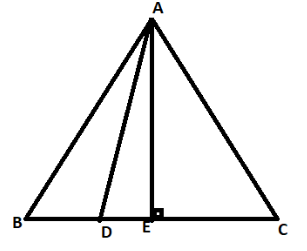Answer
418.8k+ views
Hint: In this question draw a line perpendicular to the base of the triangle and use the property of an equilateral triangle in which perpendicular drawn from vertex to base bisects the base.
Complete step-by-step answer:

Given
$ABC$ an equilateral triangle in which $4BD = BC$
$\therefore BD = \dfrac{{BC}}{4}$
Now draw a line $AE$ perpendicular to base $BC$
And as we know that in an equilateral triangle perpendicular drawn from vertex to base bisects the base.
Since $AE$ is perpendicular to $BC$ then we can say that:
$BE = EC = \dfrac{{BC}}{2}$
Now take triangle AED, apply the Pythagoras theorem we get:
$A{D^2} = A{E^2} + D{E^2}$.....take this as equation first
Similarly in triangle AEB
$A{B^2} = A{E^2} + B{E^2}$.....take this as equation second
Now putting the value of $A{E^2}$ from equation second in equation first we get:
$A{D^2} = A{B^2} - B{E^2} + D{E^2}$
Now, \[AB = BC\]as ABC is an equilateral triangle, $BE = \dfrac{{BC}}{2}$ proved above, $DE = BE - BD$ and $BD = \dfrac{{BC}}{4}$ given in question.
After replacing the values equation will be:
\[\
A{D^2} = B{C^2} - {\left( {\dfrac{{BC}}{2}} \right)^2} + {\left( {BE - BD} \right)^2} \\
A{D^2} = B{C^2} - \dfrac{{B{C^2}}}{4} + {\left( {\dfrac{{BC}}{2} - \dfrac{{BC}}{4}} \right)^2} \\
A{D^2} = B{C^2} - \dfrac{{B{C^2}}}{4} + \dfrac{{B{C^2}}}{{16}} \\
A{D^2} = \dfrac{{16B{C^2} - 4B{C^2} + B{C^2}}}{{16}} \\
A{D^2} = \dfrac{{13B{C^2}}}{{16}} \\
16A{D^2} = 13B{C^2} \\
\]
Hence proved $16A{D^2} = 13B{C^2}$
Note: In this question it's given that $4BD = BC$, from here we related that $BD = \dfrac{{BC}}{4}$ after that we applied the Pythagoras theorem in triangles AED and AEB and put the value of $A{E^2}$ from equation second in equation first, after that we replaced the values of $AB$, $BE$, $DE$ and $BD$ and further simplified the equation and got the final result as \[16A{D^2} = 13B{C^2}\] which was required to be proved.
Complete step-by-step answer:

Given
$ABC$ an equilateral triangle in which $4BD = BC$
$\therefore BD = \dfrac{{BC}}{4}$
Now draw a line $AE$ perpendicular to base $BC$
And as we know that in an equilateral triangle perpendicular drawn from vertex to base bisects the base.
Since $AE$ is perpendicular to $BC$ then we can say that:
$BE = EC = \dfrac{{BC}}{2}$
Now take triangle AED, apply the Pythagoras theorem we get:
$A{D^2} = A{E^2} + D{E^2}$.....take this as equation first
Similarly in triangle AEB
$A{B^2} = A{E^2} + B{E^2}$.....take this as equation second
Now putting the value of $A{E^2}$ from equation second in equation first we get:
$A{D^2} = A{B^2} - B{E^2} + D{E^2}$
Now, \[AB = BC\]as ABC is an equilateral triangle, $BE = \dfrac{{BC}}{2}$ proved above, $DE = BE - BD$ and $BD = \dfrac{{BC}}{4}$ given in question.
After replacing the values equation will be:
\[\
A{D^2} = B{C^2} - {\left( {\dfrac{{BC}}{2}} \right)^2} + {\left( {BE - BD} \right)^2} \\
A{D^2} = B{C^2} - \dfrac{{B{C^2}}}{4} + {\left( {\dfrac{{BC}}{2} - \dfrac{{BC}}{4}} \right)^2} \\
A{D^2} = B{C^2} - \dfrac{{B{C^2}}}{4} + \dfrac{{B{C^2}}}{{16}} \\
A{D^2} = \dfrac{{16B{C^2} - 4B{C^2} + B{C^2}}}{{16}} \\
A{D^2} = \dfrac{{13B{C^2}}}{{16}} \\
16A{D^2} = 13B{C^2} \\
\]
Hence proved $16A{D^2} = 13B{C^2}$
Note: In this question it's given that $4BD = BC$, from here we related that $BD = \dfrac{{BC}}{4}$ after that we applied the Pythagoras theorem in triangles AED and AEB and put the value of $A{E^2}$ from equation second in equation first, after that we replaced the values of $AB$, $BE$, $DE$ and $BD$ and further simplified the equation and got the final result as \[16A{D^2} = 13B{C^2}\] which was required to be proved.
Recently Updated Pages
Three beakers labelled as A B and C each containing 25 mL of water were taken A small amount of NaOH anhydrous CuSO4 and NaCl were added to the beakers A B and C respectively It was observed that there was an increase in the temperature of the solutions contained in beakers A and B whereas in case of beaker C the temperature of the solution falls Which one of the following statements isarecorrect i In beakers A and B exothermic process has occurred ii In beakers A and B endothermic process has occurred iii In beaker C exothermic process has occurred iv In beaker C endothermic process has occurred

The branch of science which deals with nature and natural class 10 physics CBSE

The Equation xxx + 2 is Satisfied when x is Equal to Class 10 Maths

Define absolute refractive index of a medium

Find out what do the algal bloom and redtides sign class 10 biology CBSE

Prove that the function fleft x right xn is continuous class 12 maths CBSE

Trending doubts
Difference between Prokaryotic cell and Eukaryotic class 11 biology CBSE

Difference Between Plant Cell and Animal Cell

Select the word that is correctly spelled a Twelveth class 10 english CBSE

Fill the blanks with the suitable prepositions 1 The class 9 english CBSE

What is the z value for a 90 95 and 99 percent confidence class 11 maths CBSE

Give 10 examples for herbs , shrubs , climbers , creepers

What organs are located on the left side of your body class 11 biology CBSE

What is BLO What is the full form of BLO class 8 social science CBSE

Change the following sentences into negative and interrogative class 10 english CBSE



